Skin laser treatments, our specialty
What are medical lasers?
Laser is the acronym for the English term Light Amplification by the Stimulated Emission of Radiation. Simply explained, it is a very intense light source of a specific wavelength with a very high energy of an orderly formation which can be accurately aimed at a very small spot.
Thanks to these properties it has been discovered that provided an appropriate pulse duration and energy flux is used, medical lasers can be precisely aimed and used to consciously influence, damage or destroy certain parts of the skin while the surrounding tissues remain intact. The purpose of a laser treatment is, for example, to reach pigment cells or blood vessels without damaging the normal skin structures, in order to achieve a dermatologic or aesthetic improvement of the skin.
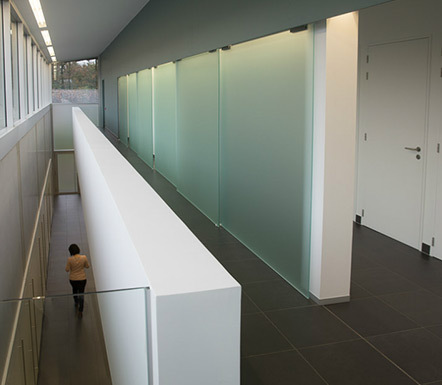
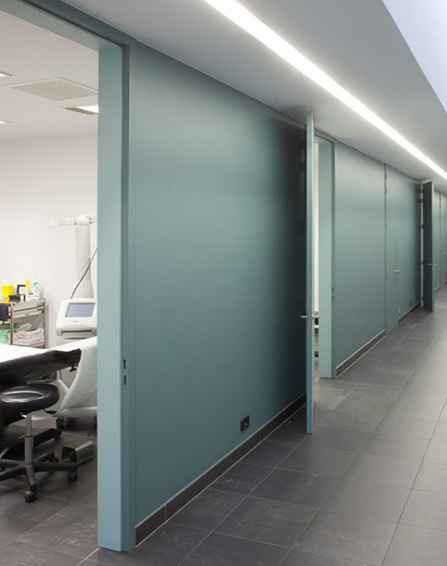
Tried and tested laser equipment with proven effectiveness
Not all skin problems can be treated with one and the same laser. At the Cutaneous Laser Centre, we have several medical lasers, which our dermatologists expertly use in function of the skin disorder so that we can achieve an optimal result.
At the Cutaneous Laser Centre, we always strive to work with the latest and best-performing equipment. However, we never perform experimental treatments. We only buy new devices when their effectiveness has been proven and when they present a substantial improvement in relation to the already existing devices.
More infoThe centre
Centre for medical and aesthetic skin laser treatments
The Cutaneous Laser Centre is a medical centre which specializes in both medical and aesthetic dermatology through laser treatments. The CLC was established in 1998 by Dr Bart Crevits. In 2003, the Cutaneous Laser Centre moved to its current location in Aalter, where several experienced dermatologists collaboratively perform various qualitative skin treatments.
At the Cutaneous Laser Centre, we have seven treatment rooms where we can treat the most varied skin problems with a dozen different laser systems. On the first floor, we also perform treatments under general anaesthesia.
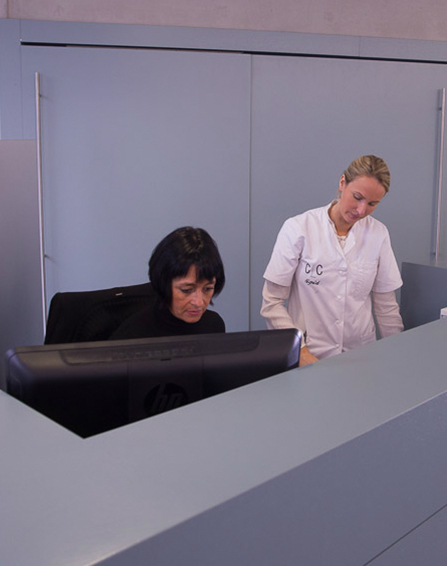
The latest and most efficient equipment
Since the nineties, there has been an enormous evolution with regard to specific laser equipment for treating skin problems. Every year, new devices come on the market which either are an improvement of the existing equipment or can be used for new applications.
At the Cutaneous Laser Centre (CLC), we aspire to have the most efficient system for any skin disorder or any skin problem. In addition to real lasers, for specific applications, we also work with devices based on intense pulsed light (IPL, Intense Pulsed Laser), infrared radiation, radio waves, sound waves (ultrasonic) and deep freezing.
Medical laser skin treatments
- Skin problems based on defects of the fine blood vessels, including congenital port-wine naevi, couperose and rosacea on the face, redness on the neck (erythrosiscolli) and fine red to broader bluish red veins in the legs (venectasia)
- Congenital or acquired pigmentation on the skin
- UltraPulse ablation with the vaporizing laser for all kinds of wart-like or elevated skin lesions, including birthmarks (intradermal naevi), warts (verrucae), cholesterol deposits (xanthelasmata), sweat gland tumours (syringomas), etc. Some precursors and superficial malignant skin lesions can also be treated.
Aesthetic skin treatments
Cosmetic treatments due to disfiguring skin problems are also among our specialties. Aesthetic skin problems can be the result of a skin condition, an accident, or simply because of old age. Often, it is about feeling better about ourselves, and there is nothing wrong with that. The Cutaneous Laser Centre offers a wide range of specialized devices that can be used for a variety of dermatological cosmetic treatments.
Although we can never guarantee with absolute certainty that a skin disorder will disappear completely, we strive to reduce it as much as possible. We always work in consultation with our patients and seek out together what treatment best suits your needs
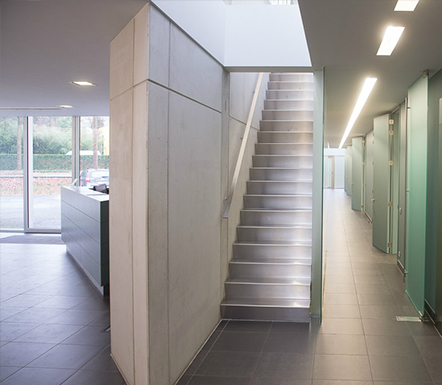
Specialist doctors continuously trained and retrained
By working with the latest equipment, we can also offer the latest treatments. However, no matter how simple some treatments may seem, defining the appropriate wavelength, pulse duration and fluence requires a thorough knowledge of both dermatology and laser physics. With the improper use of such equipment, wounds, scars, pigmentation damage or eye problems can occur. The follow-up and aftercare of skin treatments require the necessary knowledge of healing reactions and, in some cases, we have to give a specific medical prescription.
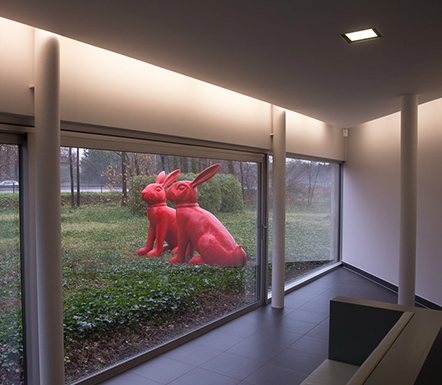
For these reasons, a decision by the Belgian Royal Academy of Medicine unequivocally states that these treatments only belong in a medical practice, under the supervision and responsibility of a physician, and not in a beauty salon.
Therefore, every medical laser requires specific training. Indeed, it is the intention to achieve the best results possible with a minimum number of treatments and negligible risks. The specific training for our treating physicians takes place at the Cutaneous Laser Centre itself. During treatment by your dermatologist, Dr Bart Crevits is always present at the CLC in case theoretical or practical assistance should be required.

Treatments
- Couperose and neck redness
- Port-wine naevi or angiomas
- Venectasia of the legs
- Pigmentation spots
- Tattoo removal
- Laser depilation - permanent hair removal
- UltraPulse CO2 laser ablation skin lesions
- Moles or naevi
- Non-ablative skin rejuvenation
- Skin firming with Titan laser treatment
- Skin rejuvenation or resurfacing with the fractioned CO2 laser
- Venus Freeze treatment
- Cryolipolysis - Figure correction removal of body fat
- Skin rejuvenation through laser surgery
1. Couperose and neck redness
Couperose (Erythrosisfaciei) is a harmless skin condition where certain parts of the face have an abnormal red dyschromia. The most sensitive areas are the cheeks and / or the nose, but sometimes the forehead and parts of the chin can also be affected.
The laser devices we use, produce a very powerful light wave with specific wavelengths, which is perfectly aimed at the target it needs to reach. In couperose or neck redness, the red blood cells in the dilated capillaries are our target.
More info2. Port-wine naevi or angiomas
A port-wine naevus (angioma or naevus flammeus) is a benign, congenital skin lesion in which all the capillaries in a given skin area are dilated due to a defect in the closing mechanism of these capillaries. The disfiguring angiomas sometimes have a reddish-purple colour and are therefore also called wine spots. Wine spots on the skin have no identifiable cause and are rarely familial.
More info3. Venectasia of the legs
Venectasia, also called telangiectasia, is a cluster of small blood vessels which develop just beneath the skin surface. These are small blood vessels that dilate a few tenths of a millimetre to a few millimetres in diameter. They are red, blue or purple and sometimes look like a spider's web. If they spread in the same direction, they look like a broom or a paintbrush. That is why, in Belgium, they are sometimes also called 'bezemrijsvaatjes' ('broomstick veins') or 'penseeladers' ('paint brush veins'). Venectasia is a benign phenomenon and rather constitutes an aesthetic problem. It occurs mainly on the legs and more in women than in men. Venectasia is not the same as varicose veins, which are identifiable by their swelling.
More info4. Pigmentation spots
Pigmentation spots on the skin are caused by an accumulation of pigment. When several pigment cells are close together, they form a brown spot on the skin, also called freckles. A pigment called melanin is actually produced by cells in the epidermis. This pigment gives colour to our skin, hair and the iris of our eyes. The pigment cells protect us from the ultraviolet sunrays. Too much sun is one of the causes of pigmentation spots. That is why pigmentation is more common on the face and hands.
More info5. Tattoo removal
A tattoo is a design applied to the body for decoration. A tattoo is applied by means of a tattoo needle filled with ink, by puncturing the dermis. Professional tattoo artists use a tattoo machine with which the skin is punctured by multiple needles at the same time, 100 times per second, in order to leave the ink in the dermis and create the desired drawing. Although the colours may fade with the years, it is envisaged a tattoo remains on the body for life.
More info6. Laser depilation - permanent hair removal
Whether it is regarding abnormal excessive hair growth or cosmetically distressing facial or body hair, many people are bothered by it and do everything possible to remove the excess hair. In addition to the classic treatment methods, including shaving, wax depilation and needle electrolysis, since the nineties, you can also depilate through laser depilation. This hair removal method enables a permanent depilation in a quick and relatively comfortable manner.
More info7. UltraPulse CO2 laser ablation skin lesions
The UltraPulse CO2 laser produces a very powerful light wave that is able to heat and evaporate tissues immediately. That is why the UltraPulse CO2 laser is sometimes called the evaporating laser. With the UltraPulse CO2 laser, it is possible to evaporate the superficial cells of elevated or wart-like skin lesions, layer by layer. We do this with such precision that there is hardly any thermal damage to the underlying tissues. This way, superficial skin lesions can be completely removed without scarring, lightening of the texture or pigment damage.
We can beautifully level deeper skin lesions with a natural skin texture after recovery. Sometimes after the treatment of a deeper skin lesion, using the evaporating laser, there is some lightening of the texture. However, this is less disruptive than a surgical scar.
More info8. Moles or naevi
Moles (naevi) are benign accumulations of pigment-forming cells in the skin. Moles are a normal phenomenon. The official medical term for these benign moles is naevus naevocellularis.
Almost everyone develops a number of naevi after puberty, some are even born with them. These are normally referred to as birthmarks (naevus congenitalis). Although usually limited in numbers, some people can develop many naevi.
More info9. Non-ablative skin rejuvenation
With non-ablative skin rejuvenation using the fractional laser, the epidermis is kept intact. The laser devices we use produce a very powerful light wave of a specific wavelength that is selectively absorbed by the tissue in the deeper layers of the skin.
Through this non-ablative laser treatment, the skin will become smoother and firmer, wrinkles will reduce and the skin structure becomes finer with finer pores. Redness and pigmentation can also be reduced with this laser treatment.
More info10. Skin firming with Titan laser treatment
Titan treatment for sagging skin is a safe, non-surgical technique in which your dermatologist uses an infrared light source to make your skin firmer and reduce the signs of aging skin.
At the Cutaneous Laser Centre, we use the Titan device to strengthen and lift the skin of the face and neck. We also treat sagging skin and excess skin in other areas of the body, including the décolleté, arms, stomach, thighs, etc.
More info11. Skin rejuvenation or resurfacing with the fractioned CO2 laser
Laser resurfacing is a laser technique in which the skin is provided with a new surface, making the skin look younger. For that reason, this technique is also sometimes referred to as skin rejuvenation. The resurfacing technique is usually used to make the skin firmer, to smooth wrinkles, fade scars and stretch marks or to improve the texture and skin pore structure. CO2 lasers are the most suitable laser devices for this.
More info12. Venus Freeze treatment
The Venus Freeze treatment is an effective treatment based on a combination of multi-polar radio frequency sound waves and pulsating magnetic fields (MP2), which lay a soothing and therapeutic thermal field on the skin.
The heat generated by the Venus Freeze device results in a shrinking effect of the protein structures (collagen), a natural recovery and renewal of the collagen (collagen neogenesis), a superficial reduction of fat cells (lipolysis) and new formation of small blood vessels (angiogenesis) through which the blood circulation improves and gives the skin a more radiant look.
More info13. Cryolipolysis - Figure correction removal of body fat
COOLtechcryolipolysis is a safe, quite painless, non-surgical figure correction treatment that removes localised body fat in a selective manner. The operating mechanism of the COOLtechcryolipolysis is based on the selective sensitivity of fat cells (adipocytes) during controlled freezing which causes controlled cell death (apoptosis) of these fat cells.
More info14. Skin rejuvenation through laser surgery
Skin ageing occurs over the years as a completely natural process. The speed and extent to which the skin ages is determined partly by genetics and partly by external factors. Lifestyle also plays an important role in skin ageing. In general, women tend to be more concerned about ageing skin than men.
More infoContact
Dr. Bart Crevits
Ganzeplas 87
B-9880 Aalter
T +32 09 216 67 20
Dr. Bostoen Jessica
1.Chrysantenstraat 21
9820 Merelbeke
T: 09/3109544
Dr. De Keyser Eline
1.Hillestraat 10A
9991 Adegem
T: 09/2265250
2.AZ Alma Ringlaan 15
9900 Eeklo
T: 09/3100452
Dr. Bart Crevits
1.Ganzeplas 87
9880 Aalter
T: 09/2166720
Dr. Myriam Deroo
1.Venakker 71 A
9880 Aalter
T: 09/3752029
Dr. T'Kint
1.Brusselbaan 34
1790 Affligem
T: 053/672555
Dr. Isabel Blockeel
1.Volhardingslaan 72 bus 12
9800 Deinze
T: 09/3861610
Dr. Libuse Matejkova
1.Fazantenstraat 33
9940 Evergem
T: 09/217 08 23 GSM 0476/23 69 64
Dr. Libuse Matejkova
1.Fazantenstraat 33
9940 Evergem
T: 09/217 08 23 GSM 0476/23 69 64
Dr. Stephanie Ryckaert
1.AZ Alma dermatologie Ringlaan 15 blok B gelijkvloer
9900 Eeklo
T: 09/3100452
2.Kalfstraat 8
8300 Knokke-Heist
T: 050/626242
Dr. Libuse Matejkova
1.Fazantenstraat 33
9940 Evergem
T: 09/217 08 23 GSM 0476/23 69 64
Dr. Erwin Suys
1.Handelskaai 1 G
8500 Kortrijk
T: 056/252650
Dr. Johan Bosschaert
1.Rotsestraat 36
8800 Roeselare
T: 051/242945
Dr. Hubert Campaert
1.G. Gezellestraat 32
8790 Waregem
T: 056/60 88 96